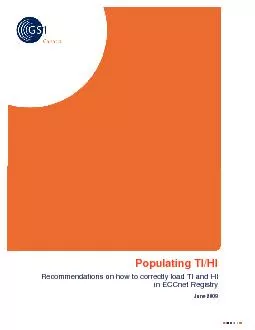/


Populating TIHI Page 2 TABLE OF C 1 PURPOSE 3 2 BACK ID: 850652
Download Pdf The PPT/PDF document "Populating TIHI Recommendations on how t..." is the property of its rightful owner. Permission is granted to download and print the materials on this web site for personal, non-commercial use only, and to display it on your personal computer provided you do not modify the materials and that you retain all copyright notices contained in the materials. By downloading content from our website, you accept the terms of this agreement.
1 Populating TI/HI Recommendations on how
Populating TI/HI Recommendations on how to correctly load TI and HI in ECCnet Registry June 2009 Populating TI/HI Page 2 TABLE OF C 1 PURPOSE ................................................................................................................................ 3 2 BACK................................................................ 3 2.1 POPULATING TI/HI ................................................................................................ 3 2.1.1 How to populate the Key TI/HI Attributes................................................................ 4 3 IMPACT ON TRADING PARTNERS ............................................................................................. 4 4 NEXT STEPS .............................................................................................................................. 4 5 FOR MORE INFORMATION ......................................................................................
2 .......... 4 Populating TI/HI Pa
.......... 4 Populating TI/HI Page 3 1 P The purpose of this document is to address the established best practices for populating the Pallet TI and Pallet HI fields within ECCnet Registry, Canada’s national product registry, and to inform users of the application and ramifications of not following the best practices. TI/HI is sometimes referred to as Tie and Tier. 2 BACKGROUND In order to ensure usable information is contained within ECCnet Registry, accurate and precise Tie (TI) and Tier (HI) information must be supplied in a timely manner for all new listings, as well as any changes that occur with the Pallet configuration. Incorrect information shared between trading p can cause significant business challenges. 2.1 Populating TI/HI TI/HI is a concept used to describe how a product is stacked on a pallet. TI is the number of cartons on a layer (Tie), and the HI is the number of layers of cartons on a pallet (Tier). The TI/HI fo
3 r the example pallet displayed in Figure
r the example pallet displayed in Figure 1 would be 10x4. Figure 1: TI/HI Example This section explains how to populate attributes describing how a trade item is palletized or otherwise prepared into a unit load (also sometimes known as a logistics unit). One of the most common forms of unit load is the pallet, used for transportation and storage purposes. Some companies use a Global Trade Item Number (GTIN to identify a standard pallet (or other unit load) of a product as a trade item in its own right (i.e. it is priced, ordered and/or invoiced). Other companies that have a product that only exists in a single unit load format (referred to as palletization) may choose to send the palletization information associated with the highest level of the product hierarchy, which is typically a case. TI - Number of Cartons on a layer = 10 HI – Number of layers = 4 Populating TI/HI Page 4 2.1.1 How to populate the Key TI/HI Attribute
4 s 1.1. Decide whether to use non-GTIN l
s 1.1. Decide whether to use non-GTIN logistics unit or a GTIN logistics unit 1.1.1. If a standard logistics unit configuration is ordered, invoiced, or priced, a GTIN needs to be assigned to it. 1.1.2. If there are multiple standard logistics unit configurations available for a synchronized item within a target market, a GTIN needs to be assigned to each configuration whether or not it is ordered, invoiced, or priced. 1.1.3. Today there are two prevalent business practices for obtaining information when there is only one standard logistics unit configuration in a target market: 1.1.3.1. At the logistics unit level when a GTIN is assigned to the logistics unit. 1.1.3.2. At the case level when a GTIN is not assigned to the logistics unit. 1.1.3.3. There are additional attributes that need to be added to support this case level processing 1.2. Determine if the product is not palletized 1.2.1. If a product is not palletized, the vendor should ind
5 icate this within ECCnet Registry by cho
icate this within ECCnet Registry by choosing Packed Loose. 3 IMPACT ON TRADING P Incorrect TI/HI information can lead to many problems within the supply chain including improperly packed trucks, retailer unable to receive orders, loss of time and money to re-set slots in the warehouse, and unused space on store shelves. 4 NEXT S Ensure that all of your TI/HI scenarios are entered properly into ECCnet Registry. If you provide any custom formations, then assign a unique GTIN to each unique configuration to ensure that it is properly loaded into ECCnet Registry and received by your trading p 5 FOR MORE I The complete Global Data Szation N (GDSN) Trade Item Implementation Guide, Issue 9, is available on GS1’s global wesbite at: GS1 Canada offers education on the practical application of all standards and on how to implement these standards within your company. If you have questions in this regard, please contact GS1 Canada at 1-7084 ext.